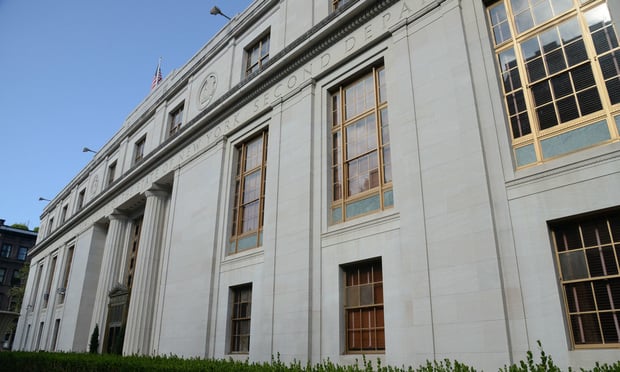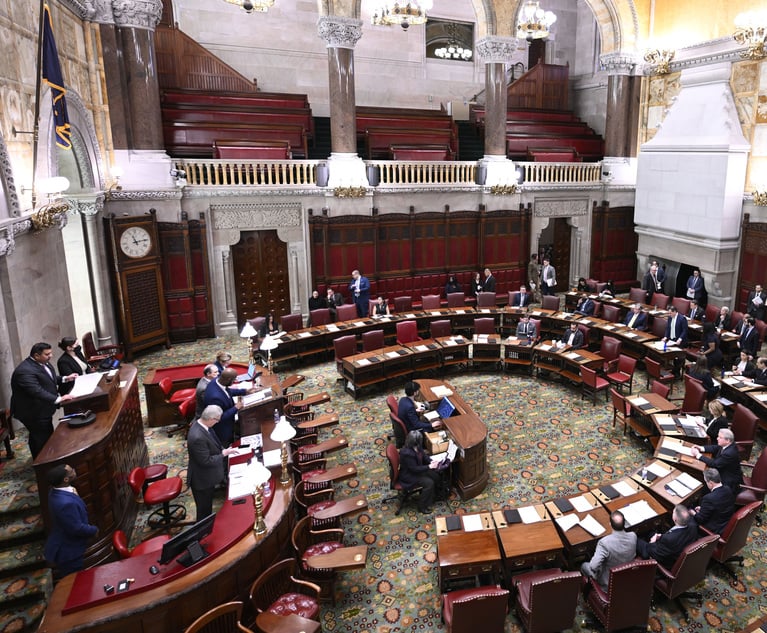NY Appeals Court Orders New Trial for Man in Case Where Judge Took Over Witness Questioning
The appellate panel ruled that the jury's guilty verdict was not against the weight of the evidence, but they found that the trial judge in the case had gone beyond his permissible capacity to intervene to clarify confusing testimony and facilitate the progress of the trial.
June 30, 2020 at 06:36 PM
3 minute read
 Appellate Division, Second Department courthouse at 45 Monroe Place in Brooklyn, NY.
Appellate Division, Second Department courthouse at 45 Monroe Place in Brooklyn, NY.
The New York Supreme Court's Appellate Division, Second Department ruled that a man accused of robbery in Queens should have a new trial before a different judge after his trial judge "improperly assumed the appearance or the function of an advocate," according to a June 24 decision.
When a Queens County prosecutor failed to elicit positive identifications of defendant Brian Mitchell from two witnesses during his 2018 jury trial, Queens County Supreme Court Justice Richard Buchter questioned them himself until they identified Mitchell, the appellate panel wrote.
"Here, the record demonstrates that after the two complainants, in response to questions by the prosecutor, were unable to positively identify the defendant as the perpetrator of the robbery, the Supreme Court improperly assumed the appearance or the function of an advocate by questioning the complainants until it elicited a positive in-court identification of the defendant from each of them. … Under these circumstances, the court's decision to elicit such testimony was an improper exercise of discretion and deprived the defendant of a fair trial," the Second Department panel, which included Justices Betsy Barros, Linda Christopher, Mark Dillon and Hector LaSalle, wrote.
Citing court documents, the Queens Daily Eagle reported that Buchter followed up with one of the witnesses nine times.
The appellate panel ruled that the jury's guilty verdict was not against the weight of the evidence, but they found that the trial judge in the case had gone beyond his permissible capacity to intervene to clarify confusing testimony and facilitate the progress of the trial.
Mitchell's attorney, Denise Fabiano of the Legal Aid Society's Criminal Appeals Bureau, praised the ruling.
"This case involved troubling identification evidence, and the judge's interference prevented the jury from evaluating the grave weaknesses in the prosecution's case," Fabiano said. "When a judge oversteps and assumes a prosecutorial role, it grossly distorts the fairness of our judicial process. We are grateful that the Second Department recognized this fundamental unfairness and ruled to rectify this miscarriage of justice."
Mitchell did not match the height, age or reported location of the alleged suspect in the nail salon robbery, according to the Legal Aid Society.
Asked about the ruling, Office of Court Administration spokesman Lucian Chalfen said the Second Department's opinion supersedes that of the trial judge, "as the criminal justice system is designed."
A spokesperson for the Queens District Attorney's Office said Tuesday that the office is studying the decision.
Read more:
Citing SCOTUS Precedent, State Appeals Court Orders Ineffective Assistance of Counsel Hearing
This content has been archived. It is available through our partners, LexisNexis® and Bloomberg Law.
To view this content, please continue to their sites.
Not a Lexis Subscriber?
Subscribe Now
Not a Bloomberg Law Subscriber?
Subscribe Now
NOT FOR REPRINT
© 2025 ALM Global, LLC, All Rights Reserved. Request academic re-use from www.copyright.com. All other uses, submit a request to [email protected]. For more information visit Asset & Logo Licensing.
You Might Like
View All
Relaxing Penalties on Discovery Noncompliance Allows Criminal Cases to Get Decided on Merit
5 minute read
Bipartisan Lawmakers to Hochul Urge Greater Student Loan Forgiveness for Public-Interest Lawyers

'Playing the Clock'?: Hochul Says NY's Discovery Loophole Is to Blame for Wide Dismissal of Criminal Cases

So Who Won? Congestion Pricing Ruling Leaves Both Sides Claiming Victory, Attorneys Seeking Clarification
4 minute readTrending Stories
- 1Who Are the Judges Assigned to Challenges to Trump’s Birthright Citizenship Order?
- 2Litigators of the Week: A Directed Verdict Win for Cisco in a West Texas Patent Case
- 3Litigator of the Week Runners-Up and Shout-Outs
- 4Womble Bond Becomes First Firm in UK to Roll Out AI Tool Firmwide
- 5Will a Market Dominated by Small- to Mid-Cap Deals Give Rise to a Dark Horse US Firm in China?
Who Got The Work
J. Brugh Lower of Gibbons has entered an appearance for industrial equipment supplier Devco Corporation in a pending trademark infringement lawsuit. The suit, accusing the defendant of selling knock-off Graco products, was filed Dec. 18 in New Jersey District Court by Rivkin Radler on behalf of Graco Inc. and Graco Minnesota. The case, assigned to U.S. District Judge Zahid N. Quraishi, is 3:24-cv-11294, Graco Inc. et al v. Devco Corporation.
Who Got The Work
Rebecca Maller-Stein and Kent A. Yalowitz of Arnold & Porter Kaye Scholer have entered their appearances for Hanaco Venture Capital and its executives, Lior Prosor and David Frankel, in a pending securities lawsuit. The action, filed on Dec. 24 in New York Southern District Court by Zell, Aron & Co. on behalf of Goldeneye Advisors, accuses the defendants of negligently and fraudulently managing the plaintiff's $1 million investment. The case, assigned to U.S. District Judge Vernon S. Broderick, is 1:24-cv-09918, Goldeneye Advisors, LLC v. Hanaco Venture Capital, Ltd. et al.
Who Got The Work
Attorneys from A&O Shearman has stepped in as defense counsel for Toronto-Dominion Bank and other defendants in a pending securities class action. The suit, filed Dec. 11 in New York Southern District Court by Bleichmar Fonti & Auld, accuses the defendants of concealing the bank's 'pervasive' deficiencies in regards to its compliance with the Bank Secrecy Act and the quality of its anti-money laundering controls. The case, assigned to U.S. District Judge Arun Subramanian, is 1:24-cv-09445, Gonzalez v. The Toronto-Dominion Bank et al.
Who Got The Work
Crown Castle International, a Pennsylvania company providing shared communications infrastructure, has turned to Luke D. Wolf of Gordon Rees Scully Mansukhani to fend off a pending breach-of-contract lawsuit. The court action, filed Nov. 25 in Michigan Eastern District Court by Hooper Hathaway PC on behalf of The Town Residences LLC, accuses Crown Castle of failing to transfer approximately $30,000 in utility payments from T-Mobile in breach of a roof-top lease and assignment agreement. The case, assigned to U.S. District Judge Susan K. Declercq, is 2:24-cv-13131, The Town Residences LLC v. T-Mobile US, Inc. et al.
Who Got The Work
Wilfred P. Coronato and Daniel M. Schwartz of McCarter & English have stepped in as defense counsel to Electrolux Home Products Inc. in a pending product liability lawsuit. The court action, filed Nov. 26 in New York Eastern District Court by Poulos Lopiccolo PC and Nagel Rice LLP on behalf of David Stern, alleges that the defendant's refrigerators’ drawers and shelving repeatedly break and fall apart within months after purchase. The case, assigned to U.S. District Judge Joan M. Azrack, is 2:24-cv-08204, Stern v. Electrolux Home Products, Inc.
Featured Firms
Law Offices of Gary Martin Hays & Associates, P.C.
(470) 294-1674
Law Offices of Mark E. Salomone
(857) 444-6468
Smith & Hassler
(713) 739-1250






